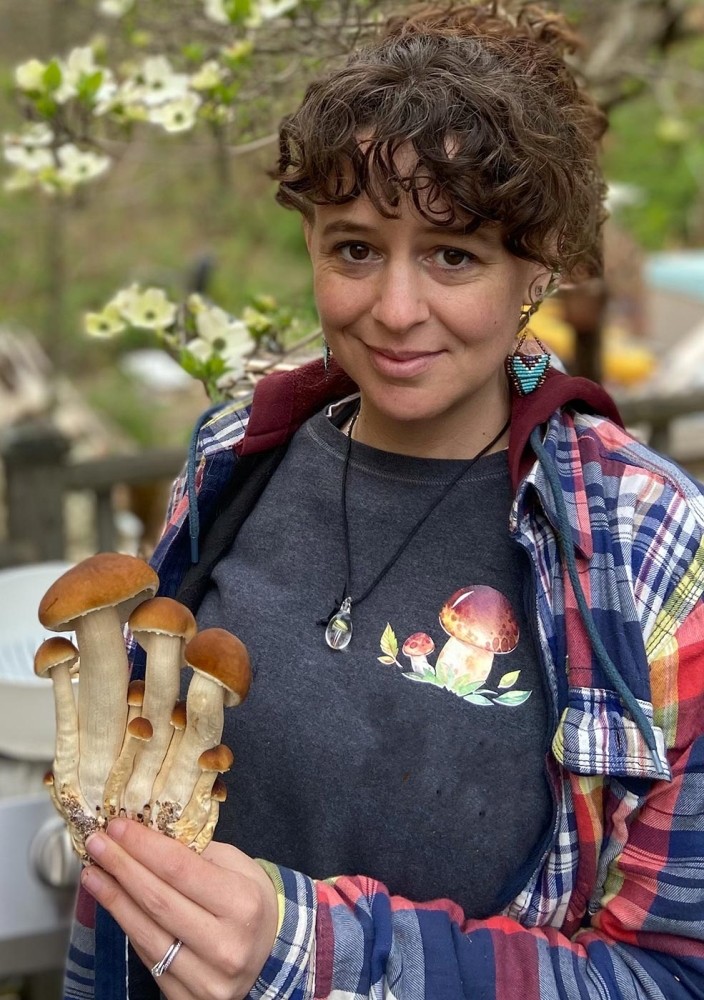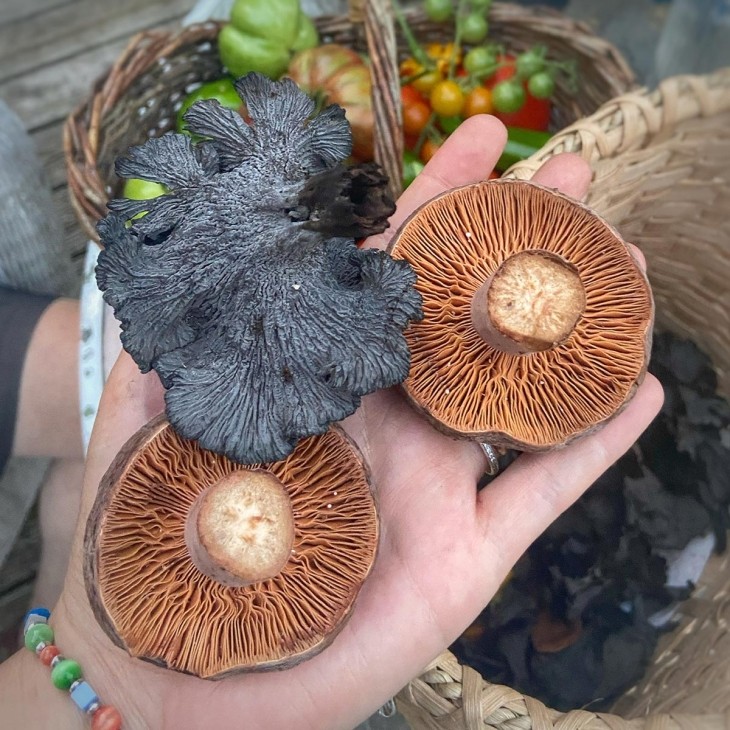
In the midst of the pandemic, Deana Tempest Thomas left her work in healthcare, purchased her childhood home in North Scituate, Rhode Island, and hatched a plan to create a small farm there. In the autumn of 2021, she started the Rhode Island Mycological Society, with a goal of educating others about fungi and documenting fungi species throughout the state. She lives with her father, her husband, her two sons, three rescue dogs, a small flock of ducks, and a pair of geese.
The land here is really special to me. We have 12 acres, and it’s just been really magical to be back in my childhood home, on this land that I played on as a kid. The trees in the back are like old friends. We’re making trails, and some day we want to open the farm up to people to be able to come and walk the land here and show them my mushroom gardens.
There’s a little stream in the back where I played as a child. Now I find mushrooms there – delicious black trumpets. When I was a kid, I didn’t really notice mushrooms. I don’t remember seeing the black trumpets. I don’t remember seeing the beautiful Amanitas or the purple Cortinarius that I find here. That’s one of the things that really amazes me – it’s a hidden kingdom. You can walk through the forest, and unless you’re really looking for them, you may not notice the fungi.
I grew up playing outside, loved being in the woods, and had a strong connection to nature. My dad took me to Mount Monadnock when I was 8, and that really stands out in my mind as a foundational memory – being on top of that mountain and looking around, how small I felt and how big and beautiful the world was. After I grew up, I would go hiking on the weekends. It was just a casual thing. One day I found this purple mushroom, and I thought, “What is this?” It was so beautiful. The purple color was so vibrant. I didn’t know a mushroom could look like that. It looked like a flower or something. I tried to figure out what it was, and I liked the challenge of it. I had to find out more.
That mushroom changed my life. It was Cortinarius iodes. They call it the viscid violet cort. It’s a mycorrhizal species that grows with oak trees. It’s very common here in New England in oak forests. After that, I was looking for mushrooms everywhere, trying to find out everything I could.
I’ve become – you could say obsessed – with fungi. Fungi are important to our ecosystem. Documenting what we have now is really important to me, so that moving forward we can have a better understanding of distribution and rarity. There are definitely rare fungi in Rhode Island. There are definitely species that are threatened. Currently, Rhode Island does not include fungi in the state database of rare and threatened species. Trying to get states to recognize fungi and put protections in place is very difficult.
My husband built a lab for me in one of our walk-in closets. I have microscopes and try to ID the fungi that I find. It’s my life’s work. It’s so important to me. Just like with plants and animals, there are fungi that are threatened, often because of changes to their habitat. We all have heard about the emerald ash borer – ash trees are critically endangered. There’s a bolete, a species of a beautiful mushroom that associates with that tree, and if the tree disappears, how will this fungus survive? Fungi are highly adaptable, so perhaps it could partner with a different tree, but evolution is a funny thing, and it could disappear.
When I first got into mushrooming, I was driving hours away to walk with people in the woods, just to be around people who knew about mushrooms. They would hold the mushroom and point out different features. Walking with those people who had intimate knowledge of the different species is how I learned. I started the Rhode Island Mycological Society to bring mushrooms to my community – and also so I didn’t have to drive so far. We had the first walk a year ago October. It’s been a great joy to meet so many wonderful, enthusiastic, curious people.
The purpose of the club is to celebrate fungi in all the ways. Some people are very interested in documenting and protecting fungi. Some people just want to know which ones they can eat. Some people are brand new and want somebody to take them through the woods. I think that people are very excited about reconnecting to the land. I think in doing that, people rediscover a part of themselves – that childlike self that has fun playing in nature. It’s been important to me to make sure everybody has access to the information and to these sorts of events. All the programs are free, and we also have events where we can gather and talk and we don’t have to walk that far, or in places where it’s more level for walking.
Ecological literacy is so important, and having that connection to the land has been something that brings me great peace and great joy. It’s like my church, walking outside. It’s my sanctuary and where I can go when things are heavy in my life. We’ve gotten away from that connection to nature. We don’t spend as much time outside. Many people can recognize main brands of clothing or food brand logos, but can you identify a tree or a plant in your yard? That deeply concerns me, so I’m trying to teach ecological literacy to children. I have a youth ambassador in the mushroom club. He’s in third grade, and he’s very enthusiastic about mushrooms and teaches his teachers about fungi.
Fungi is my big thing, but I have some knowledge of birds and plants. It’s all connected. Often, in places where woodpeckers live, there’s lots of fungi there. The woodpeckers like the trees that have the fungi, because they’re softer and have lots of bugs. Then the woodpeckers fly around and inoculate other trees with the fungi that has gotten on their beaks. There are other fungi that use insects – for instance, our stinkhorns. There are lots of connections between animals and plants and fungi that are just fascinating. And I think that’s really an important message. It’s all one big thing, and we are not separate from that. But I think a lot of people see themselves as separate from nature. Nature is outside, and we’re in these little bubbles. It’s really not that way – that’s an illusion.
We’ve been here two years now, and I’ve been slowly developing the farm, growing mushrooms, but also flowers and vegetables. It takes some time to sort of get things established and find out where are the best places to grow things. We’re growing shitakes and lion’s mane and all sorts of different oyster mushrooms and wine caps. They’re really easy to grow in your garden bed, great for nutrient recycling, and the earthworms are attracted to that. I took some classes through the Cornell small farms program on mushroom cultivation and I am certified to teach people how to grow mushrooms, and I’m hoping to do that this year.
I’m also encouraging people to participate in the Rare Fungi Challenge. The Fungal Diversity Survey has put out this challenge for all of the Northeast. There are 20 species, they’re all easily identifiable, and you can take photos and share them. These species are threatened or rare. We need more information and are concerned for them. We want as many people to know about them as possible so we can get protections in place.
I wish that people would realize that what they the choices that they make really do have an impact on the world around them – whether it’s what you plant in your yard, or how you travel through the forest. Our choices matter. That’s been empowering for me, knowing that what I see in the forest matters – the mushroom that I see and take a picture of and share with the scientists that are working on getting the protections in place for fungi, or just knowing what’s around. We want people to be out there looking for fungi and to know that what they see could be important and make a difference. All the small things add up over time. Our little choices can change the world.






Discussion *